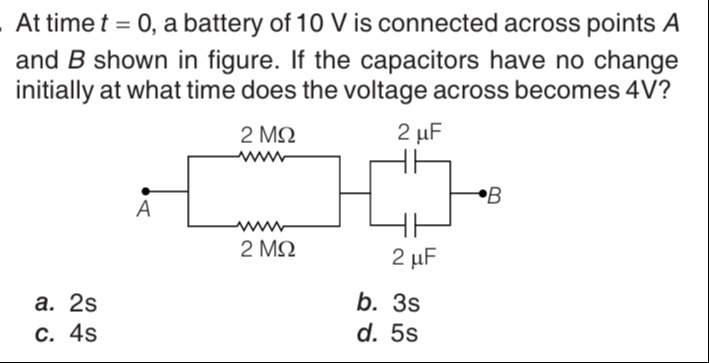Question
Question: At time $t=0$, a battery of 10 V is connected across points $A$ and $B$ shown in figure. If the capa...
At time t=0, a battery of 10 V is connected across points A and B shown in figure. If the capacitors have no change initially at what time does the voltage across becomes 4V?

2s
3s
4s
5s
2s
Solution
The circuit consists of two resistors of 2 MΩ in parallel, and two capacitors of 2 μF in parallel.
The equivalent resistance of the two parallel resistors is Req=2 MΩ+2 MΩ2 MΩ×2 MΩ=4 MΩ4 (MΩ)2=1 MΩ=1×106 Ω.
The equivalent capacitance of the two parallel capacitors is Ceq=2 μF+2 μF=4 μF=4×10−6 F.
When a battery of voltage V0=10 V is connected across points A and B at time t=0, the voltage across the capacitors as a function of time is given by the formula for charging an RC circuit:
VC(t)=V0(1−e−t/τ)
where τ is the time constant of the circuit, given by τ=ReqCeq.
Calculate the time constant τ:
τ=ReqCeq=(1×106 Ω)×(4×10−6 F)=4 s.
We are given that the voltage across the capacitors becomes VC(t)=4 V. We need to find the time t when this occurs.
Substitute the given values into the equation:
4 V=10 V(1−e−t/4)
Divide both sides by 10:
0.4=1−e−t/4
Rearrange the equation to solve for e−t/4:
e−t/4=1−0.4=0.6
Take the natural logarithm of both sides:
−t/4=ln(0.6)
t=−4ln(0.6)
Using the property ln(a)=−ln(1/a), we have ln(0.6)=ln(3/5)=−ln(5/3).
So, t=−4(−ln(5/3))=4ln(5/3).
Now we need to evaluate 4ln(5/3).
Using approximate values, ln(5/3)=ln(1.666...).
ln(5)≈1.6094 and ln(3)≈1.0986.
ln(5/3)=ln(5)−ln(3)≈1.6094−1.0986=0.5108.
t≈4×0.5108=2.0432 s.
The calculated value 2.0432 s is closest to 2s.
